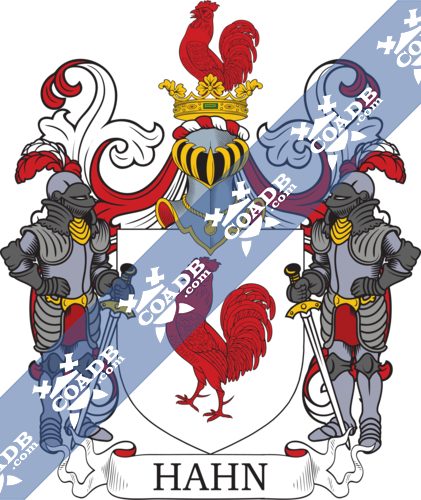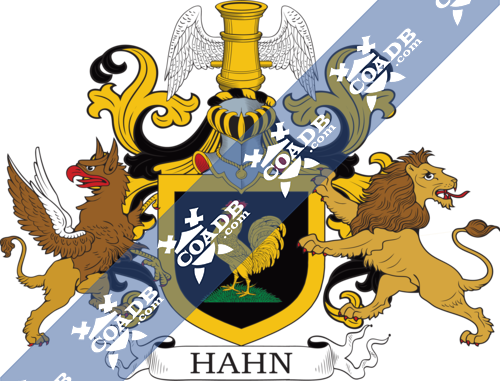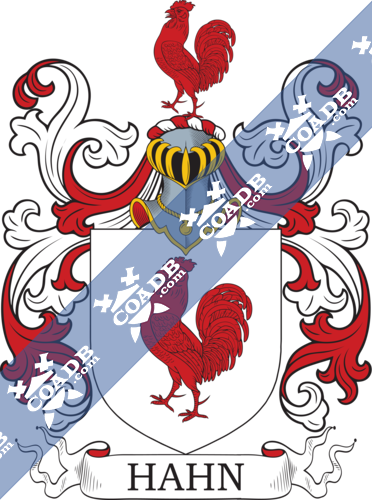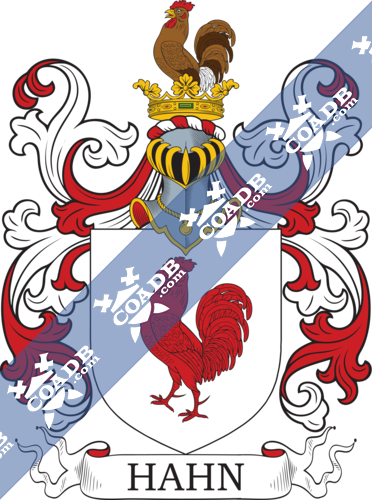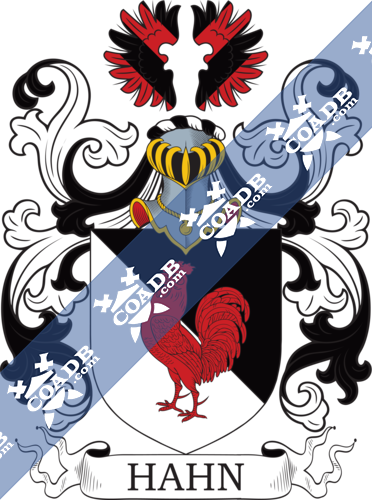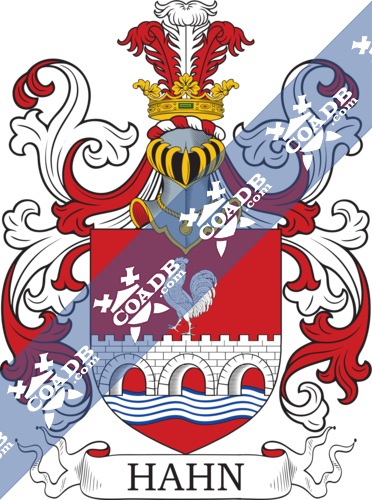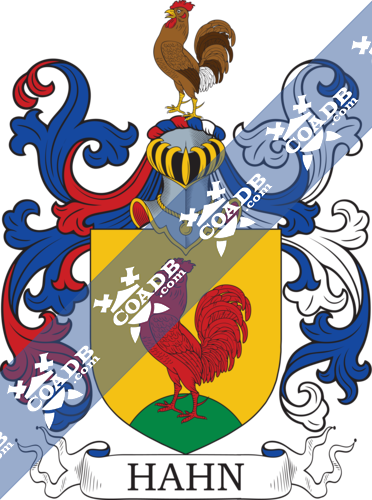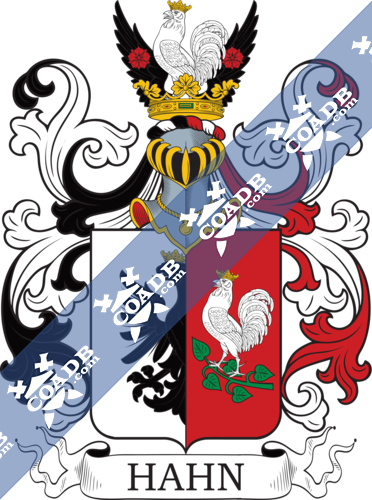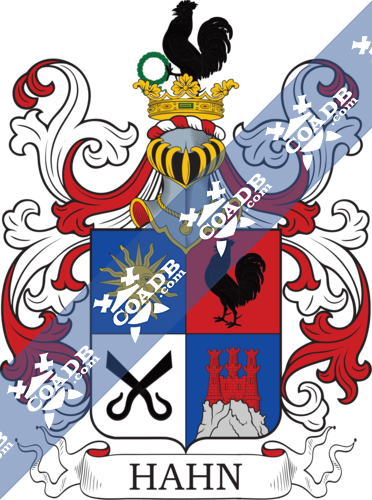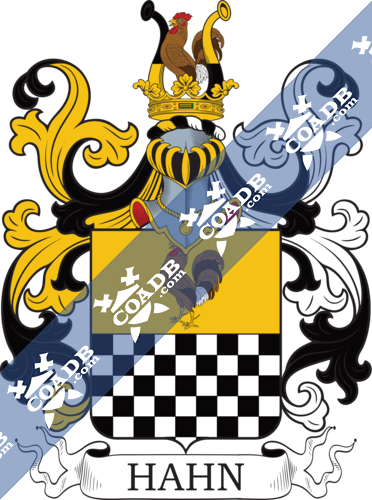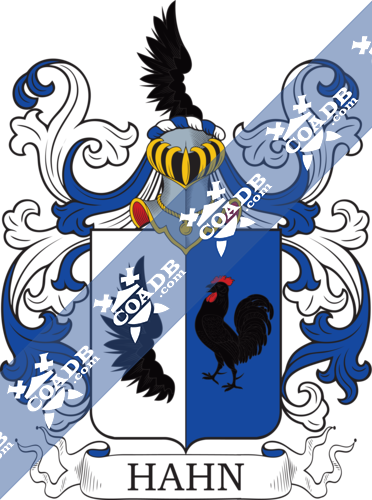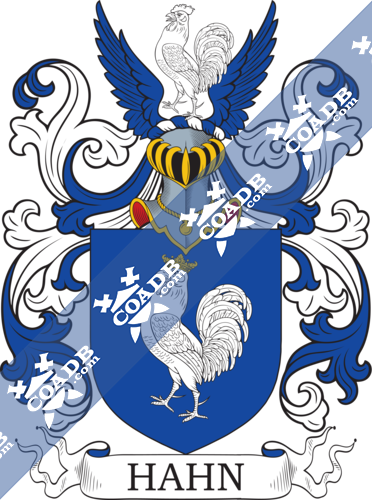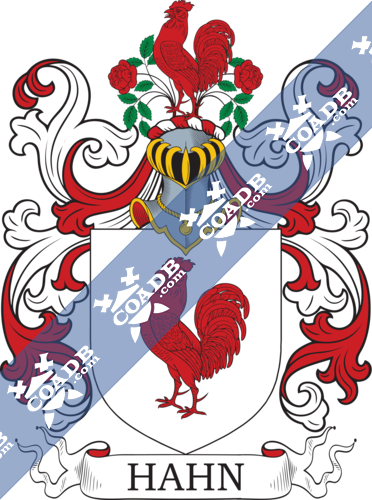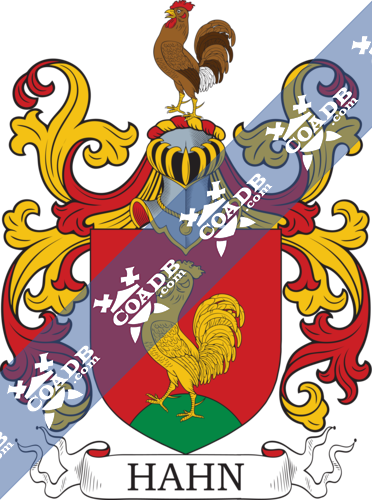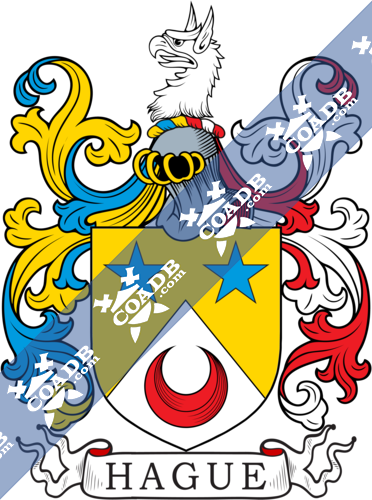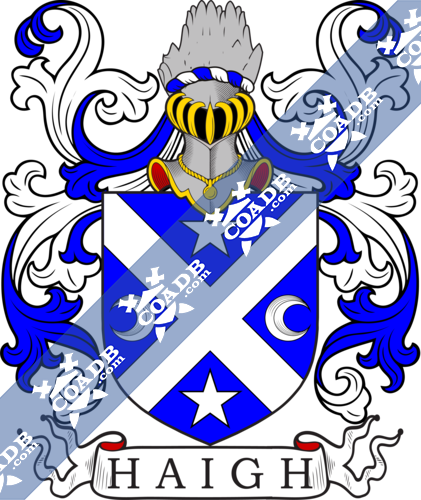Hahn Family Crest, Coat of Arms and Name History
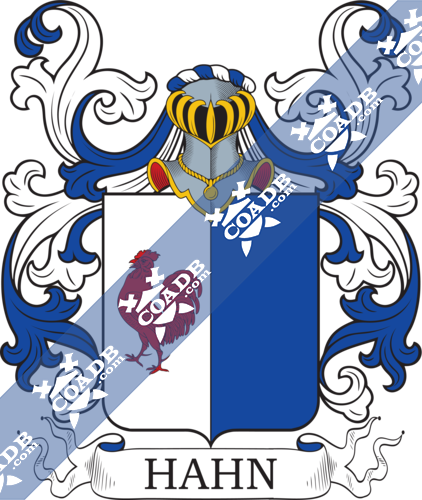
Hahn Coat of Arms Gallery
Don’t know which Coat of Arms is yours?
We can do a genealogical research. Find out the exact history of your family!
Learn MoreThis last name derives from the Middle High German word han or hane, meaning rooster. There are several theories regarding the origin of the surname Hahn. First, it may have developed as a nickname given to a person who displayed certain characteristics, in this case those of a rooster: a conceited person, or perhaps even a sexually active man. Second, it may have developed as a habitational name for a person who lived or worked at the sign of the cock: during medieval times and the Middle Ages in Europe, a significant percentage of the populous was illiterate so public houses and buildings were often marked with signs for identification. There were two signs in Frankfurt that bore the Golden Rooster and Red Rooster. Third, it may in some cases be a patronymic or baptismal surname from the reduced/shortened form of the personal name Johannes (German for John). Some claim the name first emerged in Prussia, which was a state in Germany during the Middle Ages, consisting of land in the present-day nations of Germany, Poland, Russia, Lithuania, Denmark, Belgium, Switzerland and the Czech Republic. Some common spelling variations of this last name include Hahne, Haehn, Hauhn, Haahn, and others.
The family was prominent in Mecklenburg, where a noble family of this name ruled, which can be traced all the way back to Eckhard Hahn, who lived in 1230 AD. This family owned the state of Basedow, which served as the family seat since 1337 AD. Interestingly, the coat of arms of the city of Basedow, located today in Mecklenburg-Vorpommern, Germany depicts a white and black rooster on a red shield. The von Hahn family was a noble German-Baltic-Russian family. They bore perhaps the oldest Hahn coat of arms: Argent (white), a striding rooster gules (red). Family lore states Franconia (an area in south central Germany with a distinct dialect and culture) was the ancient home of the family.
The name is very popular in Germany, where it ranks 45th. In is also well-represented in the following countries: Austria (158th), Switzerland (843rd), Denmark (923rd), and Luxembourg (440th). As of the 2000 Census, the surname Hahn was ranked 822nd in popularity. It is particular common in the following four states: Wisconsin, Nebraska, Iowa, and Minnesota. It is significantly less common in Canada where it only ranks 2,155th.
There were many bearers of this name living in colonial America. The following immigrants came in the early eighteenth century: Johann Georg Hahn (New York 1710), M.E. Hahn (Maryland 1715), Georg Philipp Hahn (Pennsylvania 1723), Maria Elizabeth Hahn (Philadelphia 1738), and Johanes Hahn (Philadelphia 1739). In Canada, one of the first bearers was Sabina Hahn, who came to Nova Scotia in 1751. A family of this surname came to the city of Wellington, New Zealand aboard the Terpischore in 1876, including: Johann Hahn (age 49), Friedricke Hahn (144), Ida Hahn, Theodor Hahn and Richard Hahn.
There are many famous or notable people with this popular German surname, including: 1) Charles Archibald “Archie” Hahn (1880-1955) who was an American track athlete who was recognized as of the best sprinters of the early twentieth century, having been born in Dodgeville, Wisconsin and attended the University of Michigan, 2) Billy Hahn (1953) who was a basketball coach born in Mishawaka, Indiana who had a long collegiate coaching career spanning from 1974-2017, 3) Carl Hugo Hahn (1818-1895) who was a German missionary and linguist who worked in South Africa, having been born near the city of Riga, Latvia, 4) Carl Wilhelm Hahn (1786-1835) who was a German zoologist known for his work on the topic of spiders, 5) James Kenneth Hahn (1950) who was the 40th Mayor of Los Angeles, California from 2001-2005, 6) Hans Hahn (1879-1934) who was an Austrian mathematician born in Vienna, Austria-Hungary who made important contributions to a variety of fields in mathematics such as topology, set theory, functional analysis, and order theory, 7) Philipp Matthaus Hahn (1739-1790) who was a German pastor, inventor, and astronomer known for devising a precision sundial, 8) William John Hahn (1841-1902) who was the Attorney General of Minnesota from 1881-1887 who had been born in Mifflin County, Pennsylvania, 9) Otto Hahn (1879-1968) who was a German chemist born in Frankfurt am Main, Hesse-Nassau, Prussia, Germany that pioneered the fields of radioactivity and radiochemistry, winning the Nobel Prize in Chemistry in 1944, and 10) Kathryne Hahn (1973) who is an American actress from Westchester, Illinois known for her roles in movies such as Anchor Man, Step Brothers, and Bad Moms.
Peter Pauwelsz de Haan was born in Sachsen (Saxony), Germany in 1520. He married Elizabeth Antonis Vink and had a son with her named Pauwel Petersz. The son Pawel P. was born in the same town in 1560. He had a son as well. This son was Hendrik Pauluszn de Haan who was born in Sachsen in 1590. He had a son named Paulus Haan who was born in Sachsen, Germany in 1626. He married Ursula Keckh and had the following issue with her: Hans Georg, Paulus, Anna Maria, Johannes, and Agnes. His son, Paulus Hahn, was born in Eningen, Baden-Wuerttemberg in 1648.
Paul Hahn was born in 1570. He had a son named Georg. Georg Hahn was born in 1625. He had a son named Johann George. This Johann George Hahn was born in 1647. He had a son named Tobia Yaney Hahn who was born in 1662. Tobia married Jachobea Grun and had a son with her named Johann Jacnob. Johann Jacob was born in Freckenfeldt, Bayern, Germany in 1682. He married Maria Otilla Eichenlaub and had two issue with her: Johannes Jacob and Maria Elizabeth (Tarwater). The son Johannes Jacob was born in Freckenfelddt, Pfalz, Bavaria in 1712. He married numerous times. He came to colonial America. His surname was sometimes spelled Honn or Hawn. He was the father of the following children: Johann Jacob, Benedict, Joshua, Eva, Elizabeth (Weaver), Christian, and Johann Jacob. His sons had children:
1) Johann Jacob was born in 1747 (married Rosanna Nigh, had issue named Elizabeth, Jacob Phillip Honn, Henry William Hawn, and William Henry Hawn)
2) Benedict was born in 1750 (married Anna Maria Hauck, had David Hawn Sr. and Christina)
3) Joshua was born in Lancaster, Pennsylvania in 1754 (had a son named Abraham)
4) Christian Hawn/Hahn was born in North Carolina in 1765 (married Anna Magdalena Schell, had sons named Sampson Hawn and Samuel Hawn)
5) Johann Jacob born in North Carolina in 1767 (had daughter named Hanna Hawn).
Johannes Hahn, born in 1712, was a farmer and linen weaver by trade and a Lutheran by faith. He was a Patriot in the American Revolutionary War, where he was a private in the North Carolina Militia. It is also interesting to note that members of the Hahn family came to England during both the Georgian and Victorian periods, and two members even fought at the Battle of Waterloo against Napoleon Bonaparte. It appears though, that Hanns had been in the British Isles for hundreds of years prior, as Durand Hann in recorded in 1238 AD, Walter de Hanne was recorded in 1250 AD, and John Hanne was documented in 1305 AD.
To receive a complete surname meaning report by PDF you can order our SURNAME MEANING PACKAGE for $129. This report is great to share with family and friends. It includes everything you see above plus any other information we can find on the specified surname. It does take approximately 10 to 15 days for us to complete this custom report.
To receive a direct lineage & coat of arms search for your specific line(s) you can order one of our GENEALOGY PACKAGES ranging in price from $249 to $999. All research is completed by a professional genealogist with over 30 years’ experience. All reports and coat of arms files are sent by email in PDF and JPG format.
Blazons & Genealogy Notes
1) P. d’Erfurt – (Nob. du St.-Empire, 26 juillet 1693) – D’argent à un coq hardi de gueules Cimier le coq. English: Argent with a cockerel raised head and right foot gules Crest: the cockerel.
2) Poméranie – D’argent à un coq hardi de gueules Casque couronné Cimier le coq de l’écu Lambrequin d’argent et de gueules Tenants deux chevaliers la visière levée le casque panaché d’argent et de gueules tenant chacun une épée abaissée Devise PRIMUS SUM QUI DEUM LAUDAT. English: Argent with a cockerel raised head and right foot gules Crowned with a helmet Crest: the cockerel of the shield Mantling: argent and gules Supporters: two knights the visors upright the helmets plumed argent and gules holding each a sword lowered Motto: PRIMUS SUM QUI DEUM LAUDAT.
3) Mecklembourg – (Comtes du St.-Empire, 7 sept. 1802) – Coupé au 1 d’or à un coq au naturel au 2 échiqueté de sable et d’argent Casque couronné Cimier le coq entre deux proboscides coupées alternativement de sable et d’or Lambrequin à dextre d’or et de sable à senestre d’argent et de sable. English: Per fess 1st or with a cockerel proper 2nd checky sable and argent Crowned with a helmet Crest: the cockerel between two proboscides per fess alternately sable and or Mantling: to the dexter or and sable to the sinister argent and sable.
4) Mecklembourg – (Nob. du St.-Empire, 6 déc. 1788; barons du St.-Empire, 25 nov. 1803. M. ét. le 17 juin 1805) – Parti au 1 d’argent à un demi-vol contourné de sable au 2 d’azur à un coq hardi de sable crêté et barbé de gueules Cimier le demi-vol contourné Lambrequin d’argent et d’azur. English: Per pale 1st argent with a single wing reversed sable 2nd azure with a cockerel raised head and right foot sable crested and jelloped gules Crest: the single wing reversed Mantling: argent and azure.
5) Silésie – (An., 13 fév. 1748) – D’azur à un coq hardi d’argent couronné d’or Cimier le coq entre un vol d’azur. English: Azure with a cockerel raised head and right foot argent crowned or Crest: the cockerel between a pair of wings azure.
6) Westphalie – De sable à un coq d’or crêté et barbé de gueules posé sur une terrasse isolée de sinople l’écu bordé du second Cimier un tube de canon d’or issant posée en pal ailé d’argent ces ailes abaissées Supports un griffon et un lion tous deux regardants au naturel armés et lampassés de gueules. English: Sable with a cockerel or crested and jelloped gules placed on a mount separated from the base vert the shield fimbriated of the second Crest: a cannon barrel or issuant placed palewise winged argent this wing abased [lower than normal] Supporters a griffin and a lion both reguardant proper armed and langued gules.
7) Prusse – (An., 17 mai 1806) – D’argent à un coq de gueules Cimier le coq accosté de deux roseaux. English: Argent with a cockerel gules Crest: the cockerel having to the sides two reeds.
8) Saxe – D’or à un coq chantant et hardi de sable posé sur un tertre de sinople Casque couronné Cimier une corne de buffle d’argent ch de trois barres ondées de sable. English: Or with a cockerel crowing and raised head and right foot sable placed on a hillock vert Crowned with a helmet Crest: buffalo horns argent charged with three bendlets sinister undy sable.
9) Bavière – (Chevaliers, 4 mars 1767) – De gueules à un coq hardi et chantant d’or posé sur un tertre de sinople Cimier le coq. English: Gules with a cockerel raised head and right foot and crowing or placed on a hillock vert Crest: the cockerel.
10) Berne – D’argent à un coq hardi de gueules Casque couronné Cimier le coq. English: Argent with a cockerel raised head and right foot gules Crowned with a helmet Crest: the cockerel.
11) (Barons) – Courlande, Livonie, Esthonie – Tranché de sable sur argent à un coq de gueules brochant sur le tout Cimier un vol à l’antique bandé de sable et de gueules de quatre pièces. English: Per bend sable over argent with a cockerel gules covering overall Crest: a pair of wings ancient bendy sable and gules of four pieces.
12) Autriche – De gueules à un casque d’argent passant sur un pont de trois arches du même s’élevant d’une eau au naturel Casque couronné Cimier trois plumes d’autruche une d’argent entre deux de gueules. English: Gules with a helmet argent passant over a bridge of three arches of the same raised above a river proper Crowned with a helmet Crest: three ostrich feathers an argent between two gules.
13) Hesse – (An., 18 août 1821) – Parti au 1 d’argent à un coq de gueules au 2 d’azur plein. English: Per pale 1st argent with a cockerel gules 2nd azure plain [uncharged].
14) Hollande – D’argent à un coq hardi de gueules soutenu d’une couronne de laurier de sinople au centre de laquelle est posée une tulipe du second tigée et feuillée du troisième Cimier un coq hardi de gueules. English: Argent with a cockerel raised head and right foot gules standing on a crown of laurel vert at the centre of which is placed a tulup of the second stemmed and leaved of the third Crest: a cockerel raised head and right foot gules.
15) Esthonie – D’or à un coq de gueules posé sur un tertre de sinople Cimier le coq Lambrequin à dextre d’azur et de gueules à senestre d’azur et d’argent. English: Or with a cockerel gules placed on a hillock vert Crest: the cockerel Mantling: to the dexter azure and gules to the sinister azure and argent.
16) Francfort-s/Main – Parti au 1 d’argent à la demi-aigle de sable couronnée d’or mouv du parti au 2 de gueules à un coq d’argent couronné d’or perché sur une branche de tilleul feuillée de sinople Casque couronné Cimier un coq d’argent couronné d’or entre un vol de sable chaque aile ch d’une rose de gueules Lambrequin à dextre d’argent et de sable à senestre d’argent et de gueules. English: Per pale 1st argent with a demi eagle sable crowned or coming from the partition [pale] 2nd gules with a cockerel argent crowned or perched over a branch of a lime tree leaved vert Crowned with a helmet Crest: a cockerel argent crowned or between a pair of wings sable each wing charged with a rose gules Mantling: to the dexter argent and sable to the sinister argent and gules.

